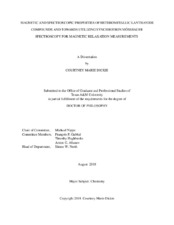| dc.description.abstract | Single-molecule magnets (SMMs) have attracted considerable attention for their fascinating
properties and exciting potential applications in next generation high-density data storage and
quantum computing. SMMs are a class of paramagnetic compounds defined by a bistable magnetic
ground state and an energy barrier (U) to reorientation of their molecular spin. Towards the utilization
of SMMs in devices, the development of methods for the control of magnetic properties via
external stimuli is required. A major objective of this research project has been the development
of lanthanide-based SMMs featuring a redox-active transition metal center, with the ultimate goal
of utilizing the redox properties of the transition metal to modulate the magnetization dynamics at
the nearby lanthanide center.
Early results in developing mixed d-block/f-block systems led to the isolation of the
dysprosium-isocarbonyl compound, [(thf)v5Dy((u-OC)W(CO)v2Cp)v3]·thf. Notably, this was the
the first structurally characterized dysprosium-isocarbonyl compound. The static and dynamic
magnetic properties of [(thf)v5Dy((µ-OC)W(CO)v2Cp)v3]·thf were characterized, revealing field-induced slow relaxation only in a magnetically dilute sample (12:1 Y^3+:Dy^3+) with Uveff = 12.6
cm^-1. However, due to instability towards oxidation/reduction, these isocarbonyl compounds were
determined to be unsuitable for redox-switchability applications. A possible route to improved
magnetization dynamics is through the development of low-coordinate lanthanide-isocarbonyl
compounds. Towards this goal, the new, bulky tungsten hydride compound, HWCp^BIG(CO)v3
(HCp^BIG = HCv5(4-n-Bu-Cv6Hv4)v5) was isolated. Gratifyingly, HWCp^BIG(CO)v3 is soluble in
non-coordinating solvents, including hexanes and toluene.
The highly reversible redox properties of ferrocence, FeCpv2, make it ideal for use
in redox-switchability applications. Towards this goal, dysprosium(III) and erbium(III)
bis(diamidoferrocene) complexes have been developed and their dynamic magnetic properties
investigated. The Dy^3+ compound exhibits either "on/off" or "slow/fast" switching in the presence
or absence of a dc field, respectively. The Er^3+ compound exhibits "on/off" functionality in the presence of a dc field. UV-vvis-NIR spectroscopy, ^57Fe Mössbauer spectroscopy, and electrochemical studies support the presence of electronic communication between the mixed-valent Fe ions in both solution and in the solid state. This molecular level study is intended to provide the foundation for future switchable solid materials based on the redox properties of ferrocene/ferrocenium.
The cyclopentadienide (Cp^-) substitution chemistry of chromocene was investigated as a synthetic
route for the generation of transition metal precursors for d-block/f-block complexes. The reaction
between chromocene and two equivalents of K(N(SiMve3)v2) generated the polymeric species,
[(N(SiMev3)v2)v2K]v∞ Carrying out the reaction in the presence of cryptand-222 afforded the
mononuclear compound [K(crypt-222)][CpCr(N(SiMev3)v2)v2]. Despite the similar coordination environments and only slight differences in geometric parameters, the polynuclear species showed
no evidence of slow relaxation whereas the mononuclear cryptand species displayed field-induced
slow relaxation with Uveff = 9.8(6) cm^-1 (Hvdc = 1000 Oe). Notably, this is only the third reported
mononuclear chromium(II)-based compound to display field-induced slow relaxation and first example that is not square planar at the Cr^2+ center.
Another major objective of this research project was the development of new techniques for
the characterization of SMMs. Mössbauer spectroscopy presents an exciting opportunity to study
magnetization dynamics at higher temperatures than currently achievable through ac magnetometry,
as the lifetime of the Mössbauer spectroscopy measurement is 5-6 orders of magnitude shorter.
In this first of its kind study, the magnetization dynamics of Dy^3+-based hexafluoroacetylacetonate
compounds were studied by ^119Sn and ^161Dy synchrotron Mössbauer spectroscopy. In the zero-field ^119Sn Mössbauer spectra, no measurable magnetic hyperfine field from the Dy^3+ center was
detected at the nearby diamagnetic Sn center. While detailed analyses of the collected ^161Dy Mössbauer spectra are currently ongoing, early observations suggest a relationship between the loss of count rate (intermediate relaxation regime) and the relaxation times/Uveff determined through ac
magnetometry studies. It remains to be determined whether or not ^161Dy synchrotron Mössbauer
spectroscopy can be utilized to extract relaxation times and calculate Uveff in Dy^3+-based SMMs. | en |


